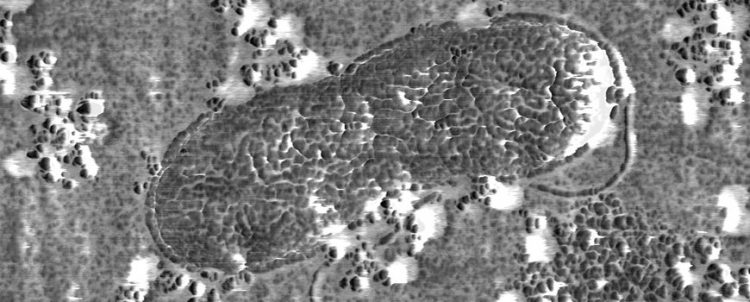Microscopic Organism Plays a Big Role in Ocean Carbon Cycling, Scripps Scientists Discover

An atomic force microscope image of the bacterial strain AltSIO (Alteromonas Scripps Institution of Oceanography)
It’s broadly understood that the world’s oceans play a crucial role in the global-scale cycling and exchange of carbon between Earth’s ecosystems and atmosphere. Now scientists at Scripps Institution of Oceanography at UC San Diego have taken a leap forward in understanding the microscopic underpinnings of these processes.
When phytoplankton use carbon dioxide to make new cells, a substantial portion of that cellular material is released into the sea as a buffet of edible molecules collectively called “dissolved organic carbon.” The majority of these molecules are eventually eaten by microscopic marine bacteria, used for energy, and recycled back into carbon dioxide as the bacteria exhale. The amount of carbon that remains as cell material determines the role that ocean biology plays in locking up atmospheric carbon dioxide in the ocean.
Thus, these “recycling” bacteria play an important role in regulating how much of the planet’s carbon dioxide is stored in the oceans. The detailed mechanisms of how the oceans contribute to this global carbon cycle at the microscopic scale, and which microbes have a leadership role in the breakdown process, are complex and convoluted problems to solve.
In a study published in the Proceedings of the National Academy of Sciences, Scripps scientists have pinpointed a bacterium that appears to play a dominant role in carbon consumption. Scripps’s Byron Pedler, Lihini Aluwihare, and Farooq Azam found that a single bacterium called Alteromonas could consume as much dissolved organic carbon as a diverse community of organisms.
“This was a surprising result,” said Pedler. “Because this pool of carbon is comprised of an extremely diverse set of molecules, we believed that many different microbes with complementary abilities would be required to breakdown this material, but it appears that individual species may be pulling more weight than others when it comes to carbon cycling.”
Pedler, a marine biology graduate student at Scripps, spent several years working with Scripps marine microbiologist Azam and chemical oceanographer Aluwihare in designing a system that would precisely measure carbon consumption by individual bacterial species. Because carbon in organic matter is essentially all around us, the most challenging part of conducting these experiments is avoiding contamination.
“Much of the carbon cycling in the ocean happens unseen to the naked eye, and it involves a complex mix of processes involving microbes and molecules,” said Azam, a distinguished professor of marine microbiology. “The complexity and challenge is not just that we can’t see it but that there’s an enormous number of different molecules involved. The consequences of these microbial interactions are critically important for the global carbon cycle, and for us.”
By demonstrating that key individual species within the ecosystem can play a disproportionally large role in carbon cycling, this study helps bring us a step closer to understanding the function these microbes play in larger questions of climate warming and increased acidity in the ocean.
“In order to predict how ecosystems will react when you heat up the planet or acidify the ocean, we first need to understand the mechanisms of everyday carbon cycling—who’s involved and how are they doing it?” said Pedler. “Now that we have this model organism that we know contributes to ocean carbon cycling, and a model experimental system to study the process, we can probe further to understand the biochemical and genetic requirements for the breakdown of this carbon pool in the ocean.”
While the new finding exposes the unexpected capability of a significant species in carbon cycling, the scientists say there is much more to the story since whole communities of microbes may interact together or live symbiotically in the microscopic ecosystems of the sea.
Pedler, Aluwihare, and Azam are now developing experiments to test other microbes and their individual abilities to consume carbon.
The study was supported by the Gordon and Betty Moore Foundation Marine Microbiology Initiative through grant GBMF2758 and the National Science Foundation.
# # #
The Gordon and Betty Moore Foundation believes in bold ideas that create enduring impact in the areas of science, environmental conservation and patient care. Intel co-founder Gordon and his wife Betty established the foundation to create positive change around the world and at home in the San Francisco Bay Area. Science looks for opportunities to transform–or even create–entire fields by investing in early- stage research, emerging fields and top research scientists. Our environmental conservation efforts promote sustainability, protect critical ecological systems and align conservation needs with human development. Patient care focuses on eliminating preventable harms and unnecessary healthcare costs through meaningful engagement of patients and their families in a supportive, redesigned healthcare system. Visit us at www.Moore.orgor follow @MooreScientific.
Media Contact
All latest news from the category: Ecology, The Environment and Conservation
This complex theme deals primarily with interactions between organisms and the environmental factors that impact them, but to a greater extent between individual inanimate environmental factors.
innovations-report offers informative reports and articles on topics such as climate protection, landscape conservation, ecological systems, wildlife and nature parks and ecosystem efficiency and balance.
Newest articles

Bringing bio-inspired robots to life
Nebraska researcher Eric Markvicka gets NSF CAREER Award to pursue manufacture of novel materials for soft robotics and stretchable electronics. Engineers are increasingly eager to develop robots that mimic the…

Bella moths use poison to attract mates
Scientists are closer to finding out how. Pyrrolizidine alkaloids are as bitter and toxic as they are hard to pronounce. They’re produced by several different types of plants and are…

AI tool creates ‘synthetic’ images of cells
…for enhanced microscopy analysis. Observing individual cells through microscopes can reveal a range of important cell biological phenomena that frequently play a role in human diseases, but the process of…





















